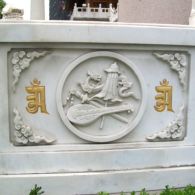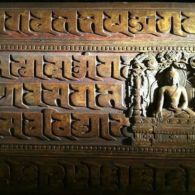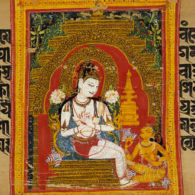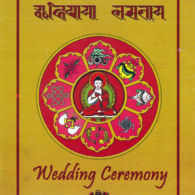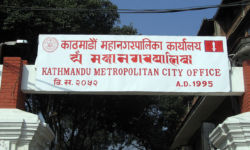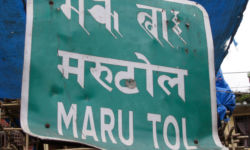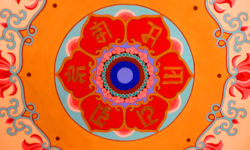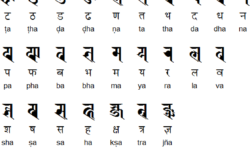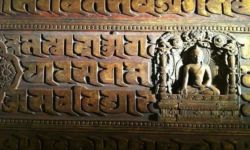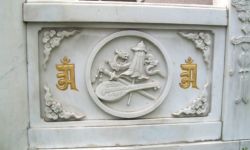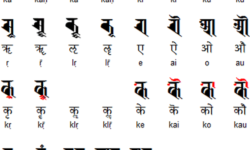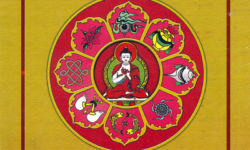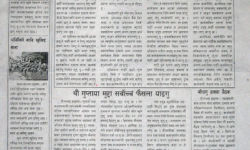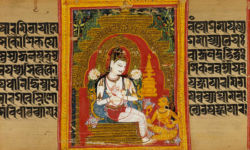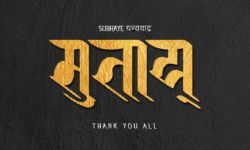Profile
Nepal has traditionally been a rich and complex linguistic culture. The Newa language, or Nepal Bhasa, has been written for a thousand years in a total of nine closely-related scripts: Ranjana, Bhujinmol, Kunmol, Kwenmol, Pachumol, Hinmol, Golmol, Litumol, and Prachalit Nepal. Collectively, these scripts are called Nepal Lipi.
Ranjana, whose name is derived from the Sanskrit word meaning “joyful,” is the boldest and most widely visible of the Nepal Lipi scripts, seen in almost every temple, stupa or monastery in Nepal, and still used for reciting sutras and mantras. It has also been seen as a holy text that will bring good fortune to the home and protect it from negative energies. An inherently calligraphic script, it is written with a clear stroke form, angled at 25-30 degrees, and each letter is seen as consisting of a head, a backbone, a tail, and in many cases a hand or torso. Ranjana can be written in both horizontal and vertical (or “monogram”) forms. The latter is called kutakshar, or “secret writing,” and was traditionally used to write sutras or to send secret messages, presumably because each word is so highly condensed and interwoven it is harder to decipher.
“You can see Ranjana script in every Buddhist monument you visit in Tibet,” Padhmadhar Tuladhar, a member of the Asa Safoo Kuthi, told the Kathmandu Post. “Tibetans believe that Ranjana is the script of their guru, Manjushree, and therefore treat the scripts with utmost reverence. That’s why the script is used so much in Tibet. You will see it everywhere, particularly on ceilings, because you always keep things that you respect at the top of your head.”
Use of the Nepal scripts began to decline when Prithvi Narayan Shah defeated King Jayaprakash Malla of Kathmandu in 1769, leading to the Gorkhali conquest of the Nepal Mandala. He began to eliminate the use of Nepalese scripts in administration and trade. Once the Rana dynasty came to power, the scripts of Nepal Lipi were completely replaced. Nepal Bhasa was removed from education, and the government abolished the use of textbooks and documents written in Nepal Lipi in favor of Devanagari.
In 1912, Rana Prime Minister Chandra Shumsher officially nullified all property ownership documents and deeds written in any language other than Gorkhali (Gorkha Bhasa), and any script other than Devanagari. The assault on the script continued for decades: in 1941, all writers and poets using it were thrown in jail, and their property confiscated.
“Books were seized and burned, but many Newa families hid their books in their dhukoos, secret wardrobes, while others, to save their ancestral texts, cast them afloat in rivers,” said Niranjan Tamrakar, current president of the Nepal Lipi Guthi, or Institute of Nepalese Epigraphy.
Even after the fall of the Rana dynasty in 1951, King Mahendra introduced a policy of, “One country, one language, one script” in the 1960s. Devanagari was enforced. “An entire generation never learned their traditional script and languages,” explained Sunita Dangol, a language activist, “pushing many languages and scripts to the verge of extinction.”
“Even after the transition to democracy, people were still not learning Ranjana, claiming that it is “too difficult, impractical, and,” she paused, ironically, “…out of use.”
“That’s when the Nepal Lipi Guthi came into the picture,” said Sharad Kasa, librarian at the Asa Saphoo Kuthi, a public library of Nepali manuscripts and a teacher of the Nepal scripts. “In 1980, Bikash Man Sheshya started the institution and played a significant role in spreading awareness about the importance of Nepal Bhasa and the history it carries. Today, the institution continues to teach people how to write in Nepal scripts under the leadership of its various guthi members,” said Kasa.
More recently, the cause of Nepalese scripts has been taken up by Callijatra, a youthful group consisting of artists, architects, engineers, photographers, calligraphers, designers and app developers. Callijatra has taken Nepal Lipi back to the streets, running workshops and demonstrations of writing, calligraphy and type design, often in markets and open public spaces in and around the Nepa Valley (Kathmandu Valley).
Apps and interactive video tutorials have been developed to teach both Ranjana and Nepal lipi, a Newa font is now available for Android, and local governments in the Kathmandu Valley has shown signs of interest in bringing Ranjana and Nepal Lipi into school curricula.
In Tibet, the Ranjana script is called Lanydza or Lantsa, and it is frequently used on the title pages of Tibetan texts, on temple walls, on prayer wheels, and in mandalas.
This usage gave the script a place of honor in Tibetan society, but that in turn made it a target: many original Sanskrit manuscripts written in Lanydza, which had been preserved in monasteries, were destroyed following the Chinese invasion of Tibet.
Updated August 2020
You can help support our research, education and advocacy work. Please consider making a donation today.
Links
General Script, Language, and Culture Resources
- Omniglot
- Wikipedia
- Unicode (PDF)
- Ranjana Script Learning App
- Ranjana Script Summary
- Ranjana Lipi Background App
- Scriptsource
- Ranjana Alphabet (PDF)
- Wikitongues – Ranjana Speaking Sample 1
- Wikitongues – Ranjana Speaking Sample 2
- Nepal Bhasa scripts are making a comeback
Community Resources
- Ranjana Script Facebook Page
- Callijatra – Promoting Ranjana Lipi Facebook
- Ranjana Lipi Facebook group
- Nepal Guthi Lipi
